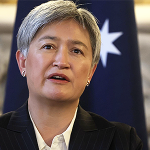When my wife and I visited Japan in springtime a few years ago, we first stayed in Ueno, near Tokyo. Next morning, strolling in glorious sunshine through Ueno Park, we were overwhelmed by a magnificent display of cherry blossoms. We had to avoid tripping over tripods as enthusiastic photographers captured the magical scene.
But as we returned to our hotel a day or so later, we found the blossoms no longer on the trees. Instead, they covered the ground like a pale pink blanket. The spectacle was over.
Then, after two enchanting weeks in Japan, we flew to Copenhagen across the vast expanse of Siberia. From the aircraft window we could see the ground glistening in deep white snow, even though it was already weeks into Spring. How cold was it down there, I wondered. It was a Dr Zhivago countryside.
Russia would probably welcome a little climate warming, I thought. Certainly, the country is doing very little about climate change, as the Climate Action Tracker reports:
Russia’s efforts to tackle climate change remain very low. Its few relevant policies are unambitious or have an unclear expected effect on emissions. Russia’s existing policies indicate no real commitment to curb emissions.
The New York Times explains in a major review How Russia Wins the Climate Crisis.
Climate change … will transform agriculture and remake the world order – and no country stands to gain more than Russia.
Russia has been explicit about its intention to come out ahead as the climate changes; in its national action plan on climate released in January, it called on the country to ‘use the advantages’ of warming and listed Arctic shipping and extended growing seasons among things that would shower ‘additional benefits’ on the nation.
Russia has the fourth largest CO2 emissions in the world, after China, America, and India. It contributes about 5 per cent of global emissions. So what are the other high-emitting countries doing about CO2 emissions?
China has the greatest CO2 emissions of any country in the world, contributing some 33 per cent of global emissions. Over the past 40 years, China’s emissions have risen fourfold, overtaking both America and Europe, as the country has industrialised. During the past few years, China’s construction of new coal-fired power plants has surged, reaching a 10-year high in 2024. This ‘resurgence’ in construction of new coal-fired power plants in China is ‘undermining’ the country’s clean-energy progress.
America is the world’s second-largest emitter of CO2, accounting for some 13 per cent of global emissions. Over the past 40 years, US emissions have doubled. However, as Chinese emissions have grown faster, American emissions have decreased slightly as a proportion of the global total.
In his inauguration address, President Donald Trump foreshadowed an Executive Order declaring a national energy emergency to bring down energy costs. ‘We will drill, baby, drill,’ he said. Energy independence for national security would have priority, along with cheaper energy for boosting manufacture. CO2 was not even mentioned.
India overtook China as the world’s most populous country in 2022. India’s CO2 emissions – like China’s – have exploded as the country has industrialised, growing by a factor of 10 over the past 40 years. They now amount to about 7 per cent of global emissions.
Despite India having signed the Paris Agreement on climate change in 2016, India continues to expand coal-fired power plants, with coal production and imports reaching record highs in 2024. While the Indian government may talk the talk on renewables, it doesn’t walk the walk:
‘The total subsidies in various forms for coal and other fossil fuels are eight times higher than those allocated to renewables.’
These four countries with the highest CO2 emissions – China, America, India, and Russia – account for nearly 60 per cent of total global emissions. While three of them pay lip service to the Paris Accords, all of them actually give priority to coal-fired power plants. Why? All clearly believe coal-fired plants provide the cheapest reliable energy. On CO2 emissions, they are muted or silent.
Australia’s CO2 emissions are insignificant, amounting to only about 1 per cent of the world total. Our entire emissions are so puny they merely match the annual increase in global emissions. Australia could shut down completely without any measurable effect on the Earth’s climate.
While Australia is obsessed with closing our remaining coal-fired power stations, the rest of the world is building new ones. According to the Global Coal Plant Tracker, as of January 2025 there were 437 coal-fired plants under construction and 645 more planned. The driving force behind this coal expansion is cheap reliable power, particularly in countries with rapidly growing industry like China and India. Reducing CO2 emissions is, at most, a low priority.
Why then does the Australian Energy Market Operator (AEMO) claim coal-generated electricity is more expensive than wind, solar, or nuclear? Their technical assessment of the GenCost 2023-24 report presents the levelised cost of electricity (LCOE) for coal, wind, solar, and nuclear. Their conclusion is that the lowest cost option is long-term operation (LTO) nuclear, followed by wind, solar, and small modular reactor (SMR) nuclear, with coal the most expensive.
AEMO’s claim that coal power is pricey not only contradicts international experience but relies on dubious assumptions. Coal Australia argues that AEMO’s high cost-estimates are due to ‘excluding realistic coal plant designs, and overstating capital and operational cost inputs’.
AEMO’s GenCost report ignores established, cost-effective coal-plant designs in favour of an expensive, unproven first-of-a-kind design. It also ignores cost-effective brownfield sites in favour of expensive greenfield sites. Using more realistic ‘real-world’ assumptions, the cost of coal-generated power halves, making it much cheaper than wind or solar.
Here’s the deal. Australia abandons cheap, reliable coal-generated electricity required by what’s left of our manufacturing industry in pursuit of Net Zero by 2050. We export vast quantities of coal to countries that don’t care about CO2 emissions, for them to use cheap coal-generated electricity to expand their manufacturing industry.
In echoes of George Orwell’s Nineteen Eighty-Four, all CO2 emissions are equal but emissions in some countries are more equal than in others. If you can make sense of this, dear reader, You’re a better man than I am, Gunga Din!
The great English scientist, Sir Isaac Newton, once said: ‘I can calculate the motion of heavenly bodies, but not the madness of people.’ Australia seems to be mad about the climate.
Dr David Phillips is a former research scientist and founder of FamilyVoice Australia.









